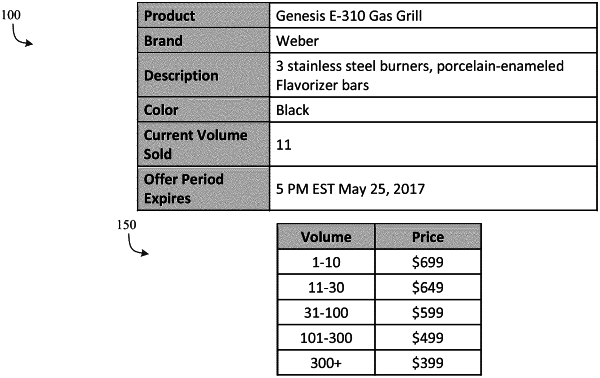| CPC G06Q 30/0206 (2013.01) [G06Q 10/067 (2013.01); G06Q 40/12 (2013.12)] | 20 Claims |

|
1. A non-transitory computer-readable storage medium comprising instructions stored therein which, when executed by one or more processors cause the one or more processors to:
calculate a plurality of target price-volume break points for a product, each of the price-volume break points includes a target selling quantity range and an associated price for the product when a total transacted quantity of sales of the product is within the target selling quantity range for a respective target-price volume break point;
trigger a time window for which the plurality of price-volume break points will be offered;
cause presentation of the plurality of target price-volume break points for the product to a purchaser, wherein the presentation is indicative of:
a current cumulative quantity of sales of the product during the time window;
a corresponding price-volume break point for the current cumulative quantity of sales; and
a remaining time within the time window for the product;
receive, for each transaction of the product occurring during the time window and corresponding to a unique purchaser of the product, transaction information comprising a transacted price for the unique purchaser, a transacted quantity for the unique purchaser, and identifying information of the unique purchaser;
update the presentation of the plurality of target price-volume break points for the product to reflect a current offered price-volume break point associated with an updated cumulative quantity of sales, wherein the updated cumulative quantity of sales is determined based on adding the transacted quantity for each received transaction to the current cumulative quantity of sales of the product during the time window;
after an expiration of the time window, generate and transmit redemptions to each unique purchaser of the product during the time window, each respective redemption based on a difference between the transacted price for the unique purchaser and a final offered price-volume break point corresponding to the total cumulative quantity of sales at the expiration of the time window;
calculate an observed market price elasticity for each of the plurality of price-volume break points;
interpolate a market price elasticity function based at least in part on the observed market price elasticities; and
optimize over the interpolated market price elasticity function to generate dynamic pricing rules, wherein the dynamic pricing rules are used to calculate updated price-volume break points for the product.
|